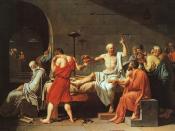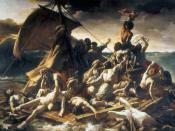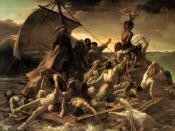Jacques-Louis David was a political figure as well as an artist. He was more closely involved in the political life of his time than any other contemporary painter. During the revolution David became a Deputy and voted for the execution of Louis XVI and his work is deeply marked by this fact. In his Death of Socrates David put Neo-classicism at the service of a morality based on Greco-Roman stoicism, self-sacrifice, and stern patriotism. The picture had a dual purpose; it was to present a non Christian morality directly to the people, and it was to prove the relationship between the art of painting of both cause and effect. Socrates, like Seneca, was proof that a high standard of morality could be achieved beyond the confines of Christianity. Similar to David was Géricault, who also can be seen as artist whose political ambitions were sometimes reflected in his paintings. He sided with the liberal opponents of the Monarchy that was restored after Napoleon.
This position is reflected in his most celebrated work, The Raft of the Medusa, a shipwreck which was a modern tragedy of epic proportions and a political scandal of the day.
The polemicism and revelation of this work was in that Géricault treated a modern subject in a grand style, which was typical of ancient heroic subjects, as in The Death of Socrates. In Géricault's opinion, modern history painting had to concern itself with events and circumstances of an immediate human interest and make its point by a direct appeal to the viewer's emotions. Despite somewhat different styles, the link between the two paintings is, therefore, that their political attitudes and emotions are reflected in similar styles and motifs. The Death of Socrates depicts the scene of a fifth-century BC Athenian prison. It is the moment...


